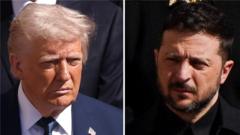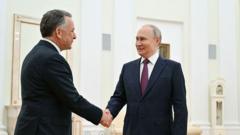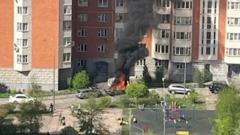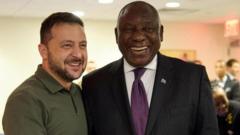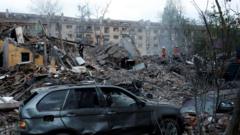The Russian central bank's latest interest rate hike, now standing at 21%, reflects growing challenges as military spending due to the war in Ukraine continues to inflate the economy, pressuring regulators to maintain stability.
Russia Raises Interest Rates to Combat Inflation Amid Military Spending Surge

Russia Raises Interest Rates to Combat Inflation Amid Military Spending Surge
Russia's central bank took decisive action to combat rising inflation by raising interest rates to 21%, the highest in over two decades, as military expenditures drive economic pressures.
The Central Bank of Russia's recent decision to raise its benchmark interest rate to 21% comes as military expenditures prompt inflationary concerns, emphasizing the delicate balance the nation must manage amid ongoing conflict.
Russia's central bank has responded to escalating inflation pressures brought on by intensive military spending by raising its benchmark interest rate to 21%—a level not seen since before 2003. This significant increase, announced during a monetary policy meeting, is aimed at slowing the rising prices that have surged due to both military recruitment and expenditures. Notably, this rate hike marks the third increase in succession, highlighting persistent inflation risks tied closely to the ongoing war in Ukraine.
Elvira Nabiullina, the president of the central bank, indicated a cautious outlook, suggesting that the rate may increase further before the year concludes. Inflation is projected to average 8.8% for the year, which is substantially higher than the rates considered healthy for the Russian economy. The situation is exacerbated by substantial government spending of $15.5 billion forecasted for the next year—primarily allocated for military aims.
Nabiullina has publicly linked these fiscal pressures to the war, arguing that excessive governmental spending undermines the main tool for inflation control—high interest rates. Companies benefiting from military contracts are willing to accept expensive loan terms, driven by urgency to meet production targets. Additionally, military recruitment has led to labor shortages, with significant numbers of Russian men either killed, injured, or fleeing the country to avoid conscription.
This tumultuous atmosphere leaves many sectors devoid of sufficient labor, elevating wage competition as companies strive to attract workers, thereby stimulating consumer spending and contributing to inflation. Interestingly, the International Monetary Fund (IMF) has reported that, despite the war's toll, Russia’s economy could see a growth rate of 3.6% in 2024, higher than previously predicted. However, experts caution that the imbalance this situation creates could threaten long-term economic stability for Russia.
Despite these economic challenges, government officials remain resolute regarding military expenditures. Finance Minister Anton Siluanov emphasized the priority of wartime spending, stating the administration will allocate necessary funds in the pursuit of victory on the battlefield. This steadfast commitment to military initiatives underscores the complex nexus of warfare and economic stability that Russian policymakers must navigate in the coming months.
Oleg Matsnev and Ivan Nechepurenko contributed to this report.
Russia's central bank has responded to escalating inflation pressures brought on by intensive military spending by raising its benchmark interest rate to 21%—a level not seen since before 2003. This significant increase, announced during a monetary policy meeting, is aimed at slowing the rising prices that have surged due to both military recruitment and expenditures. Notably, this rate hike marks the third increase in succession, highlighting persistent inflation risks tied closely to the ongoing war in Ukraine.
Elvira Nabiullina, the president of the central bank, indicated a cautious outlook, suggesting that the rate may increase further before the year concludes. Inflation is projected to average 8.8% for the year, which is substantially higher than the rates considered healthy for the Russian economy. The situation is exacerbated by substantial government spending of $15.5 billion forecasted for the next year—primarily allocated for military aims.
Nabiullina has publicly linked these fiscal pressures to the war, arguing that excessive governmental spending undermines the main tool for inflation control—high interest rates. Companies benefiting from military contracts are willing to accept expensive loan terms, driven by urgency to meet production targets. Additionally, military recruitment has led to labor shortages, with significant numbers of Russian men either killed, injured, or fleeing the country to avoid conscription.
This tumultuous atmosphere leaves many sectors devoid of sufficient labor, elevating wage competition as companies strive to attract workers, thereby stimulating consumer spending and contributing to inflation. Interestingly, the International Monetary Fund (IMF) has reported that, despite the war's toll, Russia’s economy could see a growth rate of 3.6% in 2024, higher than previously predicted. However, experts caution that the imbalance this situation creates could threaten long-term economic stability for Russia.
Despite these economic challenges, government officials remain resolute regarding military expenditures. Finance Minister Anton Siluanov emphasized the priority of wartime spending, stating the administration will allocate necessary funds in the pursuit of victory on the battlefield. This steadfast commitment to military initiatives underscores the complex nexus of warfare and economic stability that Russian policymakers must navigate in the coming months.
Oleg Matsnev and Ivan Nechepurenko contributed to this report.

